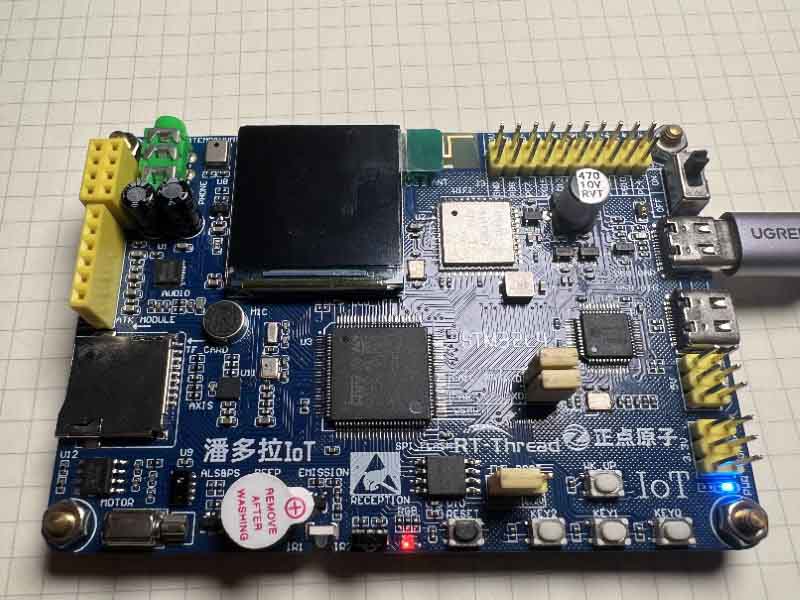Alientek STM32L475 Pandora
Overview
The STM32L475 Pandora board features an ARM Cortex-M4 based STM32L475VE MCU with a wide range of connectivity support and configurations. Here are some highlights of the STM32L475 Pandora board:
STM32L475Vx microcontroller featuring 1 Mbyte of Flash memory, 128 Kbytes of RAM in LQFP100 package
On-board ST-LINK/V2-1 supporting USB re-enumeration capability
Three different interfaces supported on USB:
Virtual com port
Mass storage
Debug port
Pushbutton (reset)
Four directions Joystick with selection
USB OTG FS with micro-AB connector
SAI Audio DAC, Stereo with output jack
Digital microphone, accelerometer, magnetometer and gyroscope MEMS
128-Mbit Quad-SPI Flash memory
MCU current ammeter with 4 ranges and auto-calibration
Connector for external board or RF-EEPROM
- Four power supply options:
ST-LINK/V2-1
USB FS connector
External 5 V
CR2032 battery (not provided)

More information about the board can be found at the STM32L475 Pandora website.
Hardware
The STM32L475VE SoC provides the following hardware features:
Ultra-low-power with FlexPowerControl (down to 130 nA Standby mode and 100 uA/MHz run mode)
Core: ARM® 32-bit Cortex®-M4 CPU with FPU, frequency up to 80 MHz, 100DMIPS/1.25DMIPS/MHz (Dhrystone 2.1)
- Clock Sources:
4 to 48 MHz crystal oscillator
32 kHz crystal oscillator for RTC (LSE)
Internal 16 MHz factory-trimmed RC ( ±1%)
Internal low-power 32 kHz RC ( ±5%)
Internal multispeed 100 kHz to 48 MHz oscillator, auto-trimmed by LSE (better than ±0.25 % accuracy)
3 PLLs for system clock, USB, audio, ADC
RTC with HW calendar, alarms and calibration
- 16x timers:
2x 16-bit advanced motor-control
2x 32-bit and 7x 16-bit general purpose
2x 16-bit basic
2x low-power 16-bit timers (available in Stop mode)
2x watchdogs
SysTick timer
Up to 82 fast I/Os, most 5 V-tolerant, up to 14 I/Os with independent supply down to 1.08 V
- Memories
Up to 1 MB Flash, 2 banks read-while-write, proprietary code readout protection
Up to 128 KB of SRAM including 32 KB with hardware parity check
External memory interface for static memories supporting SRAM, PSRAM, NOR and NAND memories
Quad SPI memory interface
4x digital filters for sigma delta modulator
- Rich analog peripherals (independent supply)
3x 12-bit ADC 5 MSPS, up to 16-bit with hardware oversampling, 200 uA/MSPS
2x 12-bit DAC, low-power sample and hold
2x operational amplifiers with built-in PGA
2x ultra-low-power comparators
- 18x communication interfaces
USB OTG 2.0 full-speed, LPM and BCD
2x SAIs (serial audio interface)
3x I2C FM+(1 Mbit/s), SMBus/PMBus
6x USARTs (ISO 7816, LIN, IrDA, modem)
3x SPIs (4x SPIs with the Quad SPI)
CAN (2.0B Active) and SDMMC interface
SWPMI single wire protocol master I/F
14-channel DMA controller
True random number generator
CRC calculation unit, 96-bit unique ID
Development support: serial wire debug (SWD), JTAG, Embedded Trace Macrocell™
Supported Features
The Zephyr stm32l475ve_pandora board configuration supports the following hardware features:
Interface |
Controller |
Driver/Component |
|---|---|---|
NVIC |
on-chip |
nested vector interrupt controller |
UART |
on-chip |
serial port-polling; serial port-interrupt |
PINMUX |
on-chip |
pinmux |
GPIO |
on-chip |
gpio |
I2C |
on-chip |
I2C-AHT10(Temperature and humidity sensor) I2C-ICM2068(light environment sensor) |
I2S |
on-chip |
I2S-ES8388(Audio Decoder) |
USB |
on-chip |
I2S-OTG |
SDIO |
on-chip |
SDIO-AP6181(WIFI) |
SPI |
on-chip |
LCD-TFT |
QSPI NOR |
on-chip |
flash |
IR-RX/TX |
on-board |
Infrared Receiver(38Khz)/Transmitter |
STLINK-V2 |
on-board |
STLINK-V2 Debugger |
Other hardware features are not yet supported on this Zephyr port.
The default configuration can be found in the defconfig file:
Connections and IOs
STM32L475 Pandora Board has 8 GPIO controllers. These controllers are responsible for pin muxing, input/output, pull-up, etc.
For more details please refer to STM32L475 Pandora board User Manual.
Default Zephyr Peripheral Mapping:
UART_1_TX : PA9
UART_1_RX : PA10
LED_R : PE7
LED_G : PE8
LED_B : PE9
System Clock
STM32L475 Pandora System Clock could be driven by an internal or external oscillator, as well as the main PLL clock. By default the System clock is driven by the PLL clock at 80MHz, driven by 16MHz high speed internal oscillator.
Serial Port
STM32L475 Pandora board has 6 U(S)ARTs. The Zephyr console output is assigned to UART2. Default settings are 115200 8N1.
Programming and Debugging
Flashing
STM32L475 Pandora board includes an ST-LINK/V2-1 embedded debug tool interface. This interface is supported by the openocd version included in Zephyr SDK.
Flashing an application to STM32L475 Pandora
Connect the STM32L475 Pandora to your host computer using the USB port, then run a serial host program to connect with your Discovery board. For example:
$ minicom -D /dev/ttyACM0
Then, build and flash in the usual way. Here is an example for the Hello World application.
# From the root of the zephyr repository
west build -b stm32l475ve_pandora samples/hello_world
west flash
You should see the following message on the console:
Hello World! arm
Debugging
You can debug an application in the usual way. Here is an example for the Hello World application.
# From the root of the zephyr repository
west build -b stm32l475ve_pandora samples/hello_world
west debug
